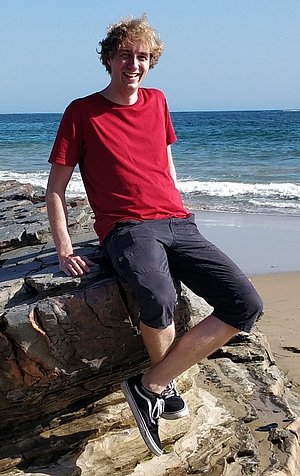The reaction free energy is the relevant thermodynamic quantity to understand the outcome and direction of a chemical reaction or biophysical process which is why many methods have been established to determine it accurately. However, interpreting the results is not always straightforward, e.g., in situations where the reaction-free energy value is relatively small due to counteracting processes.
With the aim of getting a better insight into the thermodynamics of complex formation reactions in solution, I am developing a novel computational approach to localize and decompose reaction free energies. This method calculates atom-wise energetic and entropic contributions with the goal to aid interpretation by identifying the underlying driving force and finding molecular reaction hot spots.
A crucial step is to check the accuracy and robustness of my approach compared to a well-established reference method. Hence, I wanted to learn the so-called alchemical free energy techniques to obtain reference data which led me to the theoretical group of David Mobley in California. David and his lab are focused on the prediction of free energies of binding and use and develop exactly these techniques based on molecular dynamics (MD) simulations that I am interested in. So a brief online exchange with him led to my iGSS internship at the University of California, Irvine in the United States of America from March to May 2024.
Life in the “golden state”
After arriving in Irvine, I quickly got a bike from the local thrift store and went for a ride to the ocean. I only needed one ride to the Pacific sunset to understand why so many musicians have dedicated songs to the state of California. On the one hand, you always enjoy warm, sunny spring days on the Pacific coast, which already felt like summer to me. On the other hand, you're surrounded by the beautiful green, hilly countryside that ends in a view of snow-capped mountain ranges that I enjoyed on my daily commute to work through the city.
The city of Irvine, which is located south of Los Angeles and has a similar population to Bochum, did not exist when the university was founded. Instead, it was planned and developed at the same time as the university campus in the 1960s. Included in the city’s masterplan were residential and industrial zones around the university together with greenbelts and recreational areas for 50.000 inhabitants.
As the university campus was built on undeveloped land in preparation of Californias increasing enrollment numbers, it is relatively large, decentralized and offers many open spaces with lawns and trees for relaxing. Located in the center of the campus there is a beautiful circular park surrounded by the main ring road that comprises all kinds of university buildings. What totally surprised me is that people even come here just to get married, in the heart of the campus! Around the park, some buildings are designed in the typical 60s brutalist architectural style, which at least gives you quite a homely feeling once you’ve seen the RUB campus.
Calculating the binding free energies
David’s lab is not directly located on the main campus, it’s in the adjacent research park next to it. His research group consists of six PhD students and two postdocs, all working on different fronts to predict binding free energies. Using the Local High Performance Community Computing Cluster, they are able to run many GPU-accelerated MD simulations in parallel. While their focus is mainly on predicting binding affinities for protein-ligand complexes in solution, they can easily adapt the workflow to the complex formations of small molecules i.e. crown ether complexes with alkali ions in water that I work with.
We immediately decided to apply the techniques on crown ethers - the systems I am currently investigating. First, I got accustomed with the architecture of the computing cluster and the gromacs software for running MD simulations and learned how to determine relative binding free energies. Then we planned a route to calculate absolute binding free energies via four intermediate steps. Obtaining absolute free energy values instead of relative ones is more complicated with computational methods, because crown ether systems have net charged ligands that must be accounted for correctly in all alchemical simulation steps.
Once we found all the necessary simulation settings and applied various system constraints, I calculated the Gibbs energies of complex formations for the crown ether systems. The results show, that the chosen parameters and simulation setup are suitable to reproduce experimental trends well. In the time of my internship, I was able to acquire lots of desired reference data which I can now use for benchmarks during the next development steps of my approach.
Exploring California from Irvine
For the weekends I decided to escape the office space and computer screens for little bit and visit the surrounding cities and nature reserves. Having grown up in the conurbation of the Ruhr area, I thought I was used to living in large, crowded metropolitan agglomerations. However, the sheer size of the city of Los Angeles and the surrounding region still took me by surprise. On a hike to the Griffith Observatory at Hollywood Hill, I was able to take a look at the seemingly never-ending grid of buildings that stretches to the horizon. Once you reach the top, you are confronted with not just one, but several LA skylines and six-lane highways that cut their way right through the city. In comparison, Dortmund feels much smaller and cozier.
My bike tours led me through LA along the Sunset Boulevard under palm trees; I was able to visit Hollywood, Beverly Hills and Venice Beach. The latter impressed me the most, as I really enjoyed the lifestyle on this famous stretch of coastline. On weekends, people gather here to practice all kinds of sports, be it surfing, skating, squash, yoga or volleyball. It’s a really great place to exercise and meet new people. I will also dearly miss the beautiful coasts of Crystal Cove which were perfect for relaxing and sorting my thoughts for the next work week.
All these new impressions of American cities, nature, people and working in a different lab on a new project really let time fly by! So many friendly people gave me new scientific and cultural insights and helped me to learn a lot for the future during these months. I am grateful that I was able to do this internship and would like to thank David for including me in his group and RESOLV for offering this great opportunity.
-----------------------------------------------------
About the author






